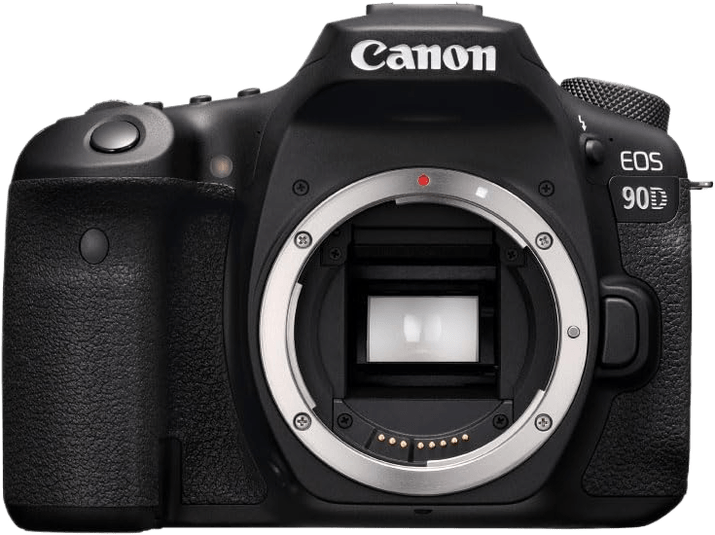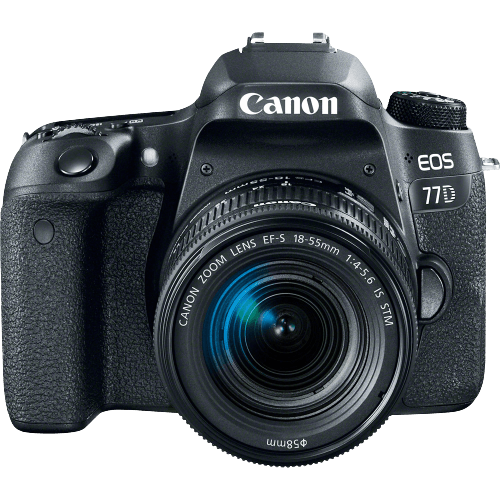Canon EOS 90D vs EOS 77D Comparison
Canon EOS 90D

Canon EOS 77D

The Canon EOS 90D takes the lead with a score of 67/100, while the Canon EOS 77D trails behind with a score of 63/100. Both cameras are DSLRs and were released in 2019 and 2017, respectively. They share similar dimensions, with the 90D measuring 141 x 105 x 77mm and the 77D at 131 x 100 x 76mm.
The winning Canon EOS 90D weighs less at 701g (1.55lbs) compared to the 77D’s 765g (1.69lbs). Additionally, the EOS 90D has a higher launch price of $1,199, reflecting its superior features. On the other hand, the Canon EOS 77D’s lower score is compensated by its more affordable launch price of $900, making it a budget-friendly option.
Taking everything into account, the Canon EOS 90D stands out as the better camera due to its higher score and lighter weight. However, the Canon EOS 77D may be a suitable alternative for those seeking a more affordable option with similar features.
Canon EOS 90D vs EOS 77D Overview and Optics
The Canon EOS 77D wins the optics comparison with a score of 64/100, while the Canon EOS 90D scores 62/100. Both cameras share some common specifications, such as a CMOS sensor, APS-C sensor size, Canon lens mounts, and a lack of image stabilization.
The EOS 90D has a higher megapixel count at 33 compared to the EOS 77D’s 24.2, which means it can capture more detailed images. Additionally, the EOS 90D’s shooting speed of 10 frames per second (fps) surpasses the EOS 77D’s 6 fps, making it better for capturing fast-moving subjects or action shots. The EOS 90D also has a more advanced image processor, the Digic 8, which generally results in better image quality and faster processing times than the EOS 77D’s Digic 7 processor.
However, the EOS 77D has a higher DXOMARK score for its sensor at 78, compared to the EOS 90D’s 58. This indicates that the EOS 77D’s sensor performance is superior, providing better dynamic range, color depth, and low-light capabilities. Despite having a lower megapixel count and shooting speed, the EOS 77D offers better sensor performance, which is an important aspect of image quality.
Comparing the two cameras, the EOS 90D excels in terms of megapixels, shooting speed, and processing power, making it suitable for capturing detailed images and fast action. On the other hand, the EOS 77D’s superior sensor performance gives it an edge in overall image quality, especially in challenging lighting conditions. Ultimately, the choice between these two cameras depends on the specific needs and priorities of the photographer.
Canon EOS 90D vs EOS 77D Video Performance
The Canon EOS 90D outperforms the Canon EOS 77D in video capabilities, boasting a video score of 91/100 compared to the 77D’s 70/100. Both cameras share some common features, including built-in time-lapse functionality. However, the 90D surpasses the 77D in several key video specifications.
The EOS 90D offers a maximum video resolution of 4K (3840 x 2160), while the EOS 77D has a maximum video resolution of Full HD (1920 x 1080). This difference in resolution means that the 90D can capture significantly more detail in its video recordings. Additionally, the 90D has a higher maximum video frame rate of 120fps compared to the 77D’s 60fps. The increased frame rate allows the 90D to produce smoother slow-motion footage and better capture fast-moving subjects.
While the EOS 77D lags behind the 90D in terms of video quality, it still provides satisfactory performance for casual users and those who do not require 4K resolution or high frame rates. Both cameras have built-in time-lapse functionality, making them suitable for capturing the passage of time in a creative manner.
Taking all of these factors into consideration, the Canon EOS 90D is the clear winner in terms of video capabilities. Its higher resolution, increased frame rate, and overall superior performance make it a more suitable choice for videographers and enthusiasts seeking top-quality video output. The Canon EOS 77D, while not as advanced in video specifications, remains a viable option for those with less demanding video needs.
Canon EOS 90D vs EOS 77D Features and Benefits
The Canon EOS 90D outperforms the Canon EOS 77D with a feature score of 83/100 compared to the 77D’s 70/100. Both cameras share several specifications, making them quite similar in many aspects. They both have a 3-inch screen size with a resolution of 1,040,000 dots, a touchscreen, flip screen, WiFi, and Bluetooth capabilities. Additionally, neither camera has GPS functionality.
The 90D’s higher score indicates that it has more advanced features than the 77D. Some of these advantages include a faster continuous shooting speed, better low-light performance, and an enhanced autofocus system. These features make the 90D more suitable for action photography, wildlife photography, and capturing fast-moving subjects.
On the other hand, the 77D has a few advantages over the 90D, despite its lower score. It is a lighter and more compact camera, making it easier to carry and handle for extended periods. This can be beneficial for those who prioritize portability and convenience over advanced features. Furthermore, the 77D is more affordable than the 90D, making it an attractive option for beginners or those on a tighter budget.
Taking these points into consideration, the Canon EOS 90D emerges as the superior camera due to its advanced features and better performance. However, the Canon EOS 77D may be more suitable for users who prioritize portability and affordability while still offering many shared features with the 90D. Ultimately, the choice between these two cameras depends on individual preferences and photography needs.
Canon EOS 90D vs EOS 77D Storage and Battery
The Canon EOS 90D outperforms the Canon EOS 77D in storage and battery with a score of 48/100, while the 77D scores 29/100. Both cameras have one memory card slot and do not support USB charging. However, there are notable differences in their capabilities.
The 90D accepts SD, SDHC, and SDXC memory cards with UHS-II compatibility, offering faster read and write speeds. In contrast, the 77D is compatible with UHS-I memory cards, which are slower. The 90D also boasts a significantly longer battery life with 1300 shots per charge using the LP-E6N battery, while the 77D manages 600 shots with the LP-E17 battery.
While the 77D falls short in storage and battery performance, it remains a viable option for casual photographers who may not require the additional speed and battery life provided by the 90D.
Considering the storage and battery capabilities, the Canon EOS 90D is the superior choice for those seeking faster memory card performance and longer battery life. However, the Canon EOS 77D remains a suitable option for those with less demanding requirements.
Canon EOS 90D vs EOS 77D – Our Verdict
Are you still undecided about which camera is right for you? Have a look at these popular comparisons that feature the Canon EOS 90D or the Canon EOS 77D:
